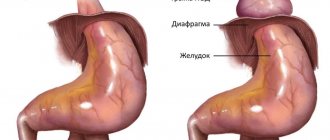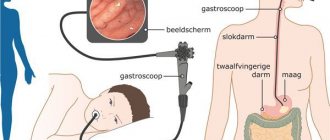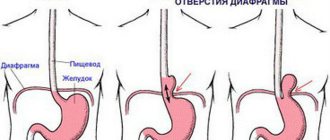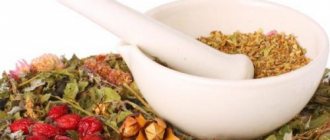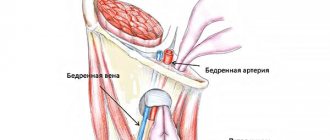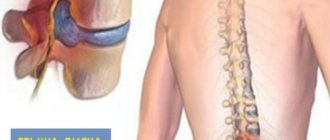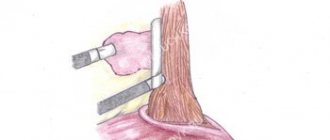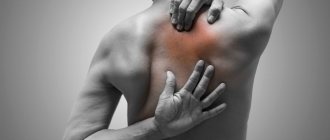Hiatal hernia
Normally, organs located under the diaphragm in the abdominal cavity cannot enter the thoracic region. This is prevented by anatomical features. Ligamentous structures formed by connective tissue fibers strengthen the esophageal diaphragmatic opening.
It is also supported by adipose tissue, which is located directly under the diaphragmatic septum. The displacement of part of the stomach, esophagus, and even intestinal loops into the chest cavity is called a hiatal hernia. Diagnosis of this disease is particularly difficult, since its symptoms are very similar to the manifestations of cholecystitis, gastritis and stomach ulcers. The patient can treat these diseases for a long time without knowing that he has a hiatal hernia.
Causes
As the disease develops, expansions of various sizes appear in the opening of the diaphragm adjacent to the esophagus (hernial orifices), under some conditions allowing part of the esophagus or stomach to enter. The main causes of a hernia are: increased pressure inside the peritoneum, disorders of motility of the digestive canal in its esophageal part, as well as weakening of connective tissue ligaments.
Based on these reasons, the development of hiatal hernia is more typical for older people due to degenerative (involutional) changes in the tissues of the diaphragm and ligaments of the stomach and esophagus. This assumption is confirmed by the frequent presence of other hernias in patients with hiatal hernias (inguinal, femoral, etc.).
People with the following chronic diseases affecting connective tissue are also predisposed to the appearance of hiatal hernias:
- Haemorrhoids.
- Varicose veins
- Flat feet.
Risk factors associated with increased intra-abdominal pressure include:
- Obstructive pulmonary diseases.
- Diseases accompanied by severe vomiting.
- Pregnancy.
- Hard physical work.
- Abdominal injuries.
- Severe flatulence, diarrhea (for example, with dysbacteriosis, infectious diseases of the gastrointestinal tract), frequent constipation.
- Tumors of the abdominal wall.
- Excess weight.
A hiatal hernia, formed due to disruption of the digestive tract, may be accompanied by the following conditions:
- Ulcers of the esophagus and fundus of the stomach, sometimes of the duodenum.
- Burns of the esophagus and stomach.
- Reflux esophagitis.
- Congenital shortening of the esophagus.
- Chronic diseases of the spleen and pancreas.
In children, hiatal hernia is a rare phenomenon, in most cases associated with a congenital defect in the structure of the digestive tract or diaphragm (mediastinum).
Reviews and results
The diet is expanded compared to Diets 1A and 1B and can be performed for a long time, as it contains the physiological norm of nutrients. Reviews from patients indicate that this diet, and especially split meals, has a beneficial effect on the condition of the esophagus and stomach: discomfort, belching and heartburn, and heaviness in the chest are eliminated.
- “... I don’t want to operate on a hernia, but frequent reflux of acidic contents caused inflammation of the esophagus without erosion. I decided that it was better to be careful (not to lift weights, etc.) and to be on medical nutrition than to have surgery right away. I adhered to it very strictly for 3 months, then expanded it a little, as my health became normal. I excluded dishes and foods that cause heartburn (lemon and all sour fruits, pickles, sweets, honey, jam). I watch my diet and take pills. I lost 5 kg in 4 months”;
- “... The hernia has been there for many years, but it does not increase and is not strangulated. Recently, heartburn began to bother me often, I was examined, and during gastroscopy they discovered superficial erosions in the esophagus. I was treated in the hospital for 3 weeks, here Table 1 B was prescribed. During the control gastroscopy, the erosions healed. At home I switched to Table 1 and observed it with all strictness for 3 months. In addition, I monitored the condition and studied the tolerance of certain foods and excluded them additionally. I'm used to steamed cutlets and meatballs, but I can eat many porridges and mashed potatoes. Sometimes I want fatty and fried foods, but I can’t have them - I immediately get heartburn and discomfort in the chest. I realized that with my illness, nutrition is the main thing”;
- “... The hernia had to be operated on because there were complications. I was in the hospital for 2 weeks, I was on diet food 1A, but more pureed meat dishes; at home I began to follow this table. They warned not to overeat and to stick to the diet for as long as possible. The work does not involve hard work, so I have enough food, I can withstand the restrictions well, especially since I need to lose another 7 kg. True, it’s inconvenient to carry dietary dishes to work, but you have to put up with it.”
Types of hiatal hernia
Comparative characteristics of the most common hiatal hernias:
- Axial (sliding). Labile penetration of the entire abdominal organ or part of it into the food opening of the diaphragm. There are: esophageal (displacement of the abdominal part of the esophagus), cardiac (displacement of the esophagus, cardia of the stomach), cardio-fundal (displacement of the esophagus, cardia and fundus of the stomach). An axial hernia is considered a false hernia because there is no hernial sac.
- Paraesophageal is a fixed displacement of the entire stomach or part of it through the food opening of the diaphragm next to the esophagus. There are: antral (displacement of the final part of the stomach) and fundal (displacement of the fundus of the stomach). It is considered a true hernia (a hernial sac is present) with a risk of strangulation.
With a long-term course of the pathology without treatment, the hernia can be differentiated as total or subtotal giant, which is no longer subject to conservative treatment.
A little about the anatomical structures involved
The human diaphragm is located approximately at the level of the lower edge of the ribs. This is a strong unpaired muscle consisting of striated fibers. It separates the thoracic and abdominal cavities. Directed with two domes upward. For the passage of the most important vessels, nerve plexuses and digestive tube, it forms 3 main openings. The food transport channel is located at level 10 of the spine. The tract is formed by muscle bundles called “medial crura”. It simultaneously contains the anterior vagus nerves.
The diaphragmatic muscles assist the digestive organs in moving food (the muscle ring in the opening serves as a sphincter). In addition they:
- support gastric motility;
- contracting simultaneously with the abdominal muscles, they reduce intra-abdominal pressure.
The functions of the diaphragm depend on its tone. In the stomach directly adjacent to the diaphragm, the following sections are distinguished:
- cardiac - the uppermost, in the zone of transition of the esophagus;
- pylorus (antrum) – is the exit to the duodenum;
- bottom – dome over the cardiac region;
- body - the area between the cardiac and pyloric regions.
All parts of the stomach are located in the abdominal cavity.
A hernia is formed by an abnormal relationship between the stomach and the diaphragm, when the enlarged passage contains underlying sections that can penetrate into the chest cavity
Symptoms
Symptoms of a hiatal hernia in many cases are mild or absent altogether. This is explained by the small size of the protrusion.
Most often, the manifestation of pathology is observed in patients with large hernias. Signs of the disease include:
- heartburn (occurs after eating);
- pain in the sternum;
- belching, feeling of fullness in the stomach;
- prolonged hiccups;
- difficulty passing food through the esophagus.
Symptoms of a hiatal hernia such as burning of the tongue (glossalgia), sour taste in the mouth, pain when bending or turning the body are often observed. Many patients complain of a feeling of a lump in the throat, increased salivation, and sudden coughing attacks, especially at night. The appearance of hernias can provoke pain in the heart area. Such signs make it difficult to diagnose the disease, as patients mistake the pathology for cardiac disorders.
Against the background of the formation of the disease, patients are diagnosed with anemia. The disease is a consequence of hidden internal bleeding in the esophagus and upper stomach.
Types of hernias UNDER
- Sliding. Another name – floating hiatal hernia – reflects the essence of the disease. The stomach, intestines or omentum enter the chest cavity periodically (freely passing back and forth). Manifestations of the disease may at times be absent and appear spontaneously when food refluxes from the stomach into the esophagus. Typically, heartburn, belching, and pain are a concern. How to relieve pain from a hiatal hernia (sliding)? Taking antacids (acid-reducing agents – Maalox, Smecta, Rennie, Almagel, etc.) helps;
- Paraesophageal (paraesophageal). Constantly located on the side of the esophagus in the chest cavity is the upper part of the stomach. The food that gets there stagnates, causing patients an extremely unpleasant, bursting sensation in the chest after eating. Therefore, they first try to eat less, and then they may even refuse to eat (for fear of pain). This behavior leads to exhaustion of the patient;
- Complicated hernias. The most dangerous thing is a strangulated hernia. The hernial sac becomes motionless in the hole, its contents cannot be evacuated. Signs of intoxication appear (high temperature, pallor, weakness, increased pulse and heart rate), vomiting of undigested food, bile and even blood. There is a high probability of rupture of the hernial sac, which can lead to mediastinitis or peritonitis, and then sepsis. Less serious complications are anemia, bleeding from the esophagus, gastritis and stomach ulcers (where it enters the hernial sac), prolapse of the stomach into the esophagus (prolapse).
It is precisely because of the risk of complications that patients need a thorough examination and decision on the issue of surgical treatment of hernia.
Diagnostics
Due to the fact that a hernia can occur in combination with many other diseases, the diagnosis of this disease can be complicated due to the similarity of symptoms.
To diagnose a hernia, doctors use the following methods to identify it:
- An X-ray machine is designed to examine the internal cavity of the body. Since the body has parts of different densities, they appear differently on an x-ray. The denser parts are the bones, which are clearly visible in the picture. To identify organ pathologies, it is necessary to administer a special contrast agent. “Illuminated” internal organs make it possible to determine the presence of pathologies;
- To determine the quality of esophageal motility, intraesophageal manometry is used. Food entering the esophagus must be delivered to the digestive organs through muscle contractions. This procedure helps to determine the dysfunction of the muscular system, determine the quality of pressure during contractions and observe the amplitude of movements. To do this, a probe with sensors that detect pressure is inserted through the nasopharynx.
Mechanism of hernia formation
According to the mechanism of development of a hernia, including axial, there can be:
- congenital - fetal anomalies, underdevelopment of the medial muscular legs of the diaphragm with impaired formation of the closing ring, are detected in childhood;
- acquired.
The study of the mechanism of acquired hernias showed significance in old age:
- atrophic changes in the muscle ring;
- prolapse of the diaphragm, causing expansion of the esophageal opening;
- relaxation of surrounding fascia.
In middle and young age, the following are more important:
- increased intra-abdominal pressure;
- a decrease in the strength of the esophageal-phrenic membrane, which fixes the position of the cardia of the stomach and esophagus, its rupture and thinning leads to the penetration of the cardia into the chest cavity.
An anatomical and physiological feature of sliding hernias is a violation of the obstacle to regurgitation (reverse movement of food). The esophagogastric junction below the diaphragm appears as an acute angle (called the angle of His). The apex of the angle forms a fold of the mucous membrane, which acts as a valve. Together with the muscle sphincter of the cardiac region, it creates a mechanical obstacle to the regurgitation process.
The development of an axial hernia causes a flattening of the angle, which leads to the disappearance of the valve. Therefore, gastroesophageal reflux occurs (return of contents from the stomach).
What to do at home?
Rules for the behavior of a patient with a diaphragmatic hernia should exclude exposure to factors that cause an increase in intra-abdominal pressure in order to prevent further displacement of organs into the chest cavity and progression of the disease:
- Take food in fractional portions every few hours;
- Before and after meals, it is recommended to drink a teaspoon of unrefined vegetable oil;
- Patients are advised to follow a special diet that excludes foods that cause intestinal irritation;
- You should not tighten your belt too tightly or wear clothes that squeeze your stomach - this creates additional pressure in the abdominal cavity;
- Avoid bending the body forward, sudden changes in body position - this can cause pain in the sternum and heartburn;
- Normalize stool - constipation and diarrhea increase intra-abdominal pressure and contribute to the formation of a hiatal hernia.
- Avoid heavy physical activity, but at the same time regularly perform physical therapy exercises that strengthen the muscle corset and restore the tone of the diaphragm;
- Pain and heartburn with a diaphragmatic hernia intensify at night and become more pronounced when the body moves to a horizontal position, so before resting it is necessary to abstain from food - the last dose is at least three hours before bedtime.
Alkaline mineral waters, such as Borjomi, help to remove symptoms of heartburn and restore the acid-base balance in the esophagus. A medicine used to neutralize gastric juice in case of diaphragmatic hernia is Almagel. It is drunk on an empty stomach, 20-30 minutes before meals, two teaspoons at a time. Regular use of the drug allows you to neutralize the negative effects of gastric juice on the walls of the esophagus and prevent the development of complications of a diaphragmatic hernia.
Classification of hernias by location
The annulus fibrosus often ruptures in the lumbosacral region. Less often - in the neck area, very rarely - in the chest.
Hernia of the lumbosacral region
The intervertebral discs in the lower back not only cushion the impacts of the vertebrae against each other, but also help support the upper body. They also provide the ability to move in a wide range (in all directions).
The main causes of protrusion in the lumbosacral region are heavy loads and disc degeneration. A common symptom is dull pain in the lower back, which is accompanied by joint stiffness. When moving, the discomfort intensifies and occurs after standing or sitting for a long time, or walking a short distance. Leaning forward, laughing, sneezing, or other sudden action may make the symptom worse.
The pain can be so excruciating that a person is unable to straighten the spine normally or even move. A tear in the annulus fibrosus causes sciatica, leg discomfort along the sciatic nerve at the back of the leg.
Other symptoms of intervertebral hernia in the lumbar region:
- Pain in the legs is worse than discomfort in the lower back. (But if it spreads down the leg along the sciatic nerve, it is sciatica).
- Burning, sharp, electric, or stabbing pain.
- Discomfort occurs in different places, depending on the location of the protrusion. It can be felt in the lower back, buttocks, thighs, lower legs, and even the feet and toes.
- The pain usually affects one side of the body.
- Neurological symptoms – numbness, tingling in the leg, foot, fingers.
- Problems lifting the foot when moving.
If a herniated disc is caused by muscle spasms in the lower back, it can be relieved by:
- Spend 1-2 days in bed, placing a pillow under your knee;
- apply heat or ice;
- sit, leaning on a comfortable backrest.
The fibrous ring often ruptures in the lumbosacral region
Thoracic hernia
The middle part of the back is the most immobile part of the spine, so hernias rarely appear here. The main reasons for their occurrence are disc deformation, trauma, cracks, and changes in the shape of the vertebrae. Sometimes scar tissue forms between the disc and the spinal cord, which can cause an anulus fibrosus defect.
Common symptoms of a thoracic hernia:
- pain in the upper, middle part of the back;
- “compression” of the heart, tingling, shooting in the chest;
- headaches when a person sits or lies in a certain position;
- numbness, pins and needles or burning in the legs;
- problems with walking, it hurts to move the lower limb;
- weakness in arms or legs;
- problems with urination or bowel movements.
Cervical hernia
The main causes of cervical hernia are disc deformation, scoliosis, and osteochondrosis. The pain can be mild, aching or acute.
Symptoms of a cervical hernia:
- The pain radiates to the right or left shoulder, between the shoulder blades. It spreads throughout the arm and can reach the hand and fingers.
- Numbness, tingling in the shoulder, arm, hands.
- Weakness of the arms and hands.
- Certain positions or movements of the neck increase pain.
- Stiffness in the neck, difficult to bend or turn to the side.
How to treat a hiatal hernia without surgery?
To eliminate the clinical manifestations of all concomitant diseases of the digestive system (gastritis, gastroesophageal reflux, ulcers, dyskinesia and erosions), an individual program of complex drug therapy is developed for each patient, including the use of:
- Proton pump inhibitors (esomeprazole, omeprazole, pantoprazole).
- Antacids (represented by Almagel, Maalox and Gastal).
- Prokinetics that improve the condition of the mucous membranes of the esophagus (ganatone, motilium, trimebutine, motilac).
- H2-antihistamines (most often ranitidine).
- B vitamins that can speed up the restoration of gastric structures.
To relieve pain, patients can be prescribed non-steroidal anti-inflammatory drugs (represented by paracetamol, ibuprofen, nurofen). In some cases, taking these medications can provoke an increase in clinical manifestations characteristic of gastroenterological diseases.
To enhance the effectiveness of drug treatment, patients are recommended to:
- adhere to a gentle diet;
- start normalizing your weight;
- during night sleep, take a semi-sitting position (thanks to the raised head of the bed);
- avoid any physical activity.
Indications for the need for surgical intervention are the presence of:
- complete failure of drug treatment;
- complicated forms of diaphragmatic hernia;
- precancerous (also called dysplastic) changes in the mucous membranes of the esophagus.
There are quite a large number of options for surgical treatment of diaphragmatic hernias.
Symptoms
Changing the position of organs leads to reflex disorders of the digestive process. The most characteristic symptoms are:
- Pain syndrome is mainly localized along the midline in the area of the angle connecting the ribs (epigastric region), retrosternally. The intensity of the pain varies, often radiating to the shoulder and back. Similar to a cardiac attack.
- Heartburn – accompanied by pain, begins after eating or during movement (contributes to gastroesophageal reflux). Patients note increased pain when lying down. The condition improves after taking milk, soda solution, and walking.
- Swallowing impairment (dysphagia) is variable, there is difficulty in swallowing dry food (“a lump gets stuck”), pain when passing food through the esophagus, belching. Often associated with concomitant esophagitis. May last for several years.
Pain is triggered by eating and physical activity
Less common:
- salivation;
- nausea and vomiting;
- prolonged hiccups;
- feeling of bitterness in the mouth;
- hoarseness of voice.
Gymnastics
For hiatal hernia, physical therapy is recommended. The following exercises help a lot:
- Lie on your side and rest your head on the cushion. Inhale deeply and inflate your stomach as much as possible, then exhale slowly and relax. Repeat 4-5 times.
- Get on your knees, straighten your back, inhale and slowly bend to the right, exhale and return to the starting position, repeat the exercise 6-7 times.
- Lie on your back. Breathing is even and calm. Slowly turn to your left and then to your right side, trying not to lose your breath.
Can the disease be cured with herbs?
It is impossible to repair a hernia or limit the mobility of the stomach using folk remedies. But unconventional herbal medicine recipes help eliminate painful symptoms. Recommended medicinal preparations used in decoctions:
- No. 1 - from coltsfoot leaves, gooseberries, mint, flaxseed, marshmallow root;
- No. 2 - calendula flowers, dried herb, burdock, wormwood, dill seeds.
Before use, you can select the most suitable plant from the collection. It is better to consult a doctor. If you have symptoms similar to a hernia, you need to undergo an examination and clarify the diagnosis. Similar symptoms accompany many diseases, so it is important to start treatment in a timely manner.
Nutrition rules and diet
In addition to taking medications for hiatal hernia, treatment involves prescribing a diet, adjusting the daily routine, and traditional medicine recipes are used as an additional measure.
There are certain diet rules that are recommended to be followed to more quickly eliminate negative symptoms:
- Meals should be small, evening meals should be completed several hours before bedtime.
- A specialist can prescribe mineral water; preference is given to alkaline waters; they are consumed 30 minutes before meals in a single volume of 100 ml.
- The possibility of overeating should be excluded, for which daily calorie counting is carried out - it should not exceed 1800-2000 kilocalories.
A patient with hiatal hernia should avoid using:
- Any fatty, fried and spicy foods.
- Fatty products made from cow's milk.
- Butter and vegetable oil.
- Coffee, chocolate and cocoa.
- Onions (both green and onions) and garlic.
- Coarse fiber found in whole nuts and grains, hard raw fruits and vegetables, bran.
- Dishes (including drinks and sauces) made from tomatoes.
- Pickles.
- Crackers and chips.
- Ice cream.
- Mustard, ketchup and vinegar.
- Any carbonated drinks.
The diet of a patient with hiatal hernia requires the presence of:
- Porridges prepared with skim milk or water.
- Dishes made from low-fat goat and cow milk.
- Lean meat and fish.
- Baked or mashed apples.
- Fresh bananas.
- Baked potatoes and carrots.
- Egg whites.
- Green peas and green beans.
- Steamed broccoli.
- Soft cookies.
- Baked goods made from rice flour.
- Marmalade, marshmallows, jelly and marshmallows.
Since a hiatal hernia occurs against the background of unbearable heartburn, it is necessary to exclude foods that can provoke its occurrence from the patient’s diet. Equally undesirable are drinks and dishes, the consumption of which leads to bloating.
Authorized Products
Patients with a hernia and after surgery spend a long time on Diet No. 1 , which includes:
- Premium quality dried wheat bread.
- Soups with vegetable broth (cereals and vegetables are pureed), seasoned with butter or egg flakes.
- Steamed dishes made from beef, lamb, lean pork, turkey and chicken.
- Steam dishes from lean fish without skin (pieces or cutlets).
- Milk, cream, non-acidic kefir, cottage cheese in the form of soufflé, pudding, fermented milk products with high acidity are excluded.
- Semolina, buckwheat and rice, cooked in water or milk. The porridge is pureed and its consistency should be semi-viscous.
- Vegetables (potatoes, cauliflower, pumpkin, carrots, beets) are steamed and served as purees or puddings.
- Fruit puree, jelly, jelly, compotes, sugar, honey.
- Tea with milk, sweet juices.
- Butter and sunflower oil (refined) - in dishes.
Table of permitted products
| Proteins, g | Fats, g | Carbohydrates, g | Calories, kcal | |
Vegetables and greens | ||||
| zucchini | 0,6 | 0,3 | 4,6 | 24 |
| cauliflower | 2,5 | 0,3 | 5,4 | 30 |
| potato | 2,0 | 0,4 | 18,1 | 80 |
| carrot | 1,3 | 0,1 | 6,9 | 32 |
| beet | 1,5 | 0,1 | 8,8 | 40 |
| pumpkin | 1,3 | 0,3 | 7,7 | 28 |
Cereals and porridges | ||||
| buckwheat (kernel) | 12,6 | 3,3 | 62,1 | 313 |
| semolina | 10,3 | 1,0 | 73,3 | 328 |
| cereals | 11,9 | 7,2 | 69,3 | 366 |
| white rice | 6,7 | 0,7 | 78,9 | 344 |
Bakery products | ||||
| wheat bread | 8,1 | 1,0 | 48,8 | 242 |
Confectionery | ||||
| jelly | 2,7 | 0,0 | 17,9 | 79 |
Raw materials and seasonings | ||||
| honey | 0,8 | 0,0 | 81,5 | 329 |
| sugar | 0,0 | 0,0 | 99,7 | 398 |
| milk sauce | 2,0 | 7,1 | 5,2 | 84 |
| sour cream sauce | 1,9 | 5,7 | 5,2 | 78 |
Dairy | ||||
| milk | 3,2 | 3,6 | 4,8 | 64 |
| cream | 2,8 | 20,0 | 3,7 | 205 |
Cheeses and cottage cheese | ||||
| cottage cheese | 17,2 | 5,0 | 1,8 | 121 |
Meat products | ||||
| boiled beef | 25,8 | 16,8 | 0,0 | 254 |
| boiled veal | 30,7 | 0,9 | 0,0 | 131 |
| rabbit | 21,0 | 8,0 | 0,0 | 156 |
Bird | ||||
| boiled chicken | 25,2 | 7,4 | 0,0 | 170 |
| turkey | 19,2 | 0,7 | 0,0 | 84 |
Eggs | ||||
| chicken eggs | 12,7 | 10,9 | 0,7 | 157 |
Oils and fats | ||||
| butter | 0,5 | 82,5 | 0,8 | 748 |
Non-alcoholic drinks | ||||
| mineral water | 0,0 | 0,0 | 0,0 | — |
Juices and compotes | ||||
| juice | 0,3 | 0,1 | 9,2 | 40 |
| jelly | 0,2 | 0,0 | 16,7 | 68 |
| rose hip juice | 0,1 | 0,0 | 17,6 | 70 |
| * data is per 100 g of product | ||||
Traditional methods of treatment
It is worth learning from traditional medicine how to treat a hernia only as an additional method of improving well-being, if the doctor who determined the tactics of treatment with diet and medication approves the auxiliary intervention.
A good addition to your diet would be to use mild, anti-inflammatory chamomile or lightly brewed green tea. When choosing infusions and herbs, you should look for an option that will reduce stomach acidity, heartburn and abdominal discomfort. Often recommended ginger and lemon teas for hernia and other gastroenterological diseases are contraindicated.
How is the diagnosis made?
Diagnosis of protrusion of the stomach into the hernial opening requires a careful questioning of the patient, clarification of the conditions under which symptoms arise, the nature of nutrition, the duration of manifestations, and signs of other stomach diseases. Upon examination, one can identify the consequences of chronic bleeding (pallor), deviation of the relative dullness of the heart, pain on palpation in the epigastrium.
The main importance is attached to the X-ray and endoscopic method. For X-ray examination, survey and contrast fluoroscopy is used (passage of contrast agent and filling of the esophagus and stomach online). Additionally, photographs (x-rays) are taken. The patient is viewed in a vertical, horizontal position, lying on his side, in the Trendelenburg position (knee-elbow).
Objective signs of a hiatal hernia include only clear evidence of displacement of part or all of the stomach into the mediastinum. Indirect signs are considered:
- absence of a gas bubble of the stomach or changes in its shape, size, supradiaphragmatic location;
- smoothness of the esophagocardial angle with a picture of a high confluence of the esophagus with a sliding hernia;
- gastroesophageal reflux with reverse reflux of contrast;
- a symptom of “throat dance”, when reverse peristalsis is observed when swallowing contrast.
Esophagogastroscopy performed using a fibrogastroscope reveals:
- sign of “cardia gape” or non-closure of the esophagus at the level of passage through the diaphragm;
- localization of the gastric cardia above the diaphragm with shortening of the esophagus;
- manifestation of gastroesophageal reflux;
- foci of epithelial degeneration.
Radiographs are taken as the contrast progresses
The endoscopic method makes it possible to assess the severity of damage to the mucous membrane of the stomach and esophagus, to exclude cancerous degeneration and other pathologies. Sometimes it is necessary to find out the degree of decompensation of the esophagocardial sphincter, which indicates the severity of reflux. For this purpose, the technique of esophagomanometry, intraesophageal pH-metry, and scintigraphy is used.
Electrocardiography can exclude myocardial ischemia. An abdominal ultrasound is performed to identify other diseases that may be causing the hernia. In case of consequences of injuries and difficulties in diagnosis, laparoscopy is used as an opportunity to examine the abdominal cavity and subdiaphragmatic space.
Differential diagnosis for diaphragmatic hernias involving the stomach is carried out:
- with cicatricial narrowing of the esophagus;
- tumor of the esophagus;
- portal hypertension;
- angina pectoris;
- peptic ulcer and cholelithiasis;
- other types of diaphragmatic hernias.
Operation
The purpose of the operation is to restore the anatomical position and normal function of the cardia. The basic principle is to eliminate the hernial orifice and perform antireflux surgery. This is done by mobilizing and lowering the esophageal-gastric junction into the abdominal cavity, narrowing the esophageal opening of the diaphragm and performing one of the types of fundoplication, which allows you to restore the lower esophageal sphincter, the high pressure zone in it and the angle of His.
- The most common is the operation by Nissen, who proposed a 360° fundoplication for the treatment of a hiatal hernia complicated by esophagitis. It consists of forming a circular cuff from the anterior and posterior walls of the fundus of the stomach, enveloping the mobilized abdominal section of the esophagus, in which a 30-32F1 probe is installed. The edges of the stomach are sutured together with the wall of the esophagus. The width of the cuff is at least 2.5-3 cm. If the hernial opening is wide (more than 3.5 cm), the legs of the diaphragm are sutured together behind or in front of the esophagus (posterior or anterior crurorrhaphy) to the normal size of the POD. When the POD diameter is more than 5 cm, to prevent recurrence of the hernia, it is advisable to strengthen the crurorrhaphy with a mesh prosthesis made of non-absorbable synthetic material.
- Fundoplication according to Nissen-Rossetti also involves a 360° fundoplication with the difference that the gastric cuff is not fixed to the diaphragm (prevention of hiccups and pain during breathing movements), but 1-2 sutures are placed between the esophagus and the gastric cuff on the side opposite from the sutures of the cuff itself (prevention of cuff expansion in the fundus of the stomach). The disadvantage of the Nissen and Nissen-Rosetti operations is the twisting of the esophagus along the axis when the fundus of the stomach is passed under it. This can be avoided by modifying the Nissen operation, in which the first short arteries of the stomach, the posterior (not covered by the peritoneum) wall of the cardia are mobilized, and the anterior and posterior walls of the fundus of the stomach are involved in creating the cuff.
- Toupet fundoplication involves the formation of a symmetrical cuff from the anterior and posterior walls of the fundus of the stomach, enveloping the esophagus at 240-270°, leaving its anterior-right surface free (localization of the left vagus nerve). Used for small stomach fundus. Many authors prefer this method of fundoplication due to the lower incidence of dysphagia in the early postoperative period (compared to the Nissen procedure). This advantage is offset in the future due to a greater number of relapses of reflux disease.
- Fundoplication according to Dor. It also involves partial fundoplication, in which the anterior wall of the fundus of the stomach is placed in front of the abdominal esophagus, fixing it to the right wall of the esophagus. This operation is ineffective; it is rarely used as a forced measure when it is impossible to fully mobilize the esophagogastric junction and perform other types of fundoplication.
- The Cuschieri operation (1991) is the creation of an acute angle of His using the round ligament of the liver, which, after partial mobilization from the navel, is carried out with the free end under the abdominal segment of the esophagus, pulling it to the right and anteriorly (an acute angle of His is formed). Rarely used due to low efficiency.
For hernias combined with pronounced shortening of the esophagus (congenital or due to esophagitis), the Collis-Nissen operation gives the best results. The operation consists of lengthening the abdominal esophagus due to the lesser curvature of the stomach, followed by gastrofundorraphy (enveloping the newly created esophageal tube from the lesser curvature with the walls of the fundus of the stomach according to the Nissen fundoplication type).
Fully or partially limited products
- Fatty and stringy meat, fatty duck and goose, meat and fish broths, canned food, smoked meats, pickled vegetables.
- Fried dishes, mushroom decoctions, tomato and mushroom sauces, fish and meat stewed in their own juices.
- Fresh bread and pastry.
- Tomatoes, radishes, white cabbage, sorrel, cucumbers, onions, mushrooms, sour fruits and berries.
- Spices and seasonings.
- Millet, barley and pearl barley cereals, pasta, legumes.
- Fermented milk products with high acidity.
- Carbonated drinks, sour juices.
The list of products may expand due to individual poor tolerance. Foods that cause heartburn , epigastric discomfort, and vomiting should be avoided.
Table of prohibited products
| Proteins, g | Fats, g | Carbohydrates, g | Calories, kcal | |
Vegetables and greens | ||||
| vegetables legumes | 9,1 | 1,6 | 27,0 | 168 |
| canned vegetables | 1,5 | 0,2 | 5,5 | 30 |
| radish | 1,2 | 0,1 | 3,4 | 19 |
| white radish | 1,4 | 0,0 | 4,1 | 21 |
| black radish | 1,9 | 0,2 | 6,7 | 35 |
| turnip | 1,5 | 0,1 | 6,2 | 30 |
| asparagus | 1,9 | 0,1 | 3,1 | 20 |
| tomatoes | 0,6 | 0,2 | 4,2 | 20 |
| horseradish | 3,2 | 0,4 | 10,5 | 56 |
Berries | ||||
| grape | 0,6 | 0,2 | 16,8 | 65 |
| gooseberry | 0,7 | 0,2 | 12,0 | 43 |
| currant | 1,0 | 0,4 | 7,5 | 43 |
Cereals and porridges | ||||
| corn grits | 8,3 | 1,2 | 75,0 | 337 |
| pearl barley | 9,3 | 1,1 | 73,7 | 320 |
| millet cereal | 11,5 | 3,3 | 69,3 | 348 |
| barley grits | 10,4 | 1,3 | 66,3 | 324 |
Flour and pasta | ||||
| pasta | 10,4 | 1,1 | 69,7 | 337 |
Bakery products | ||||
| vysivkovy bread | 9,0 | 2,2 | 36,0 | 217 |
| oatmeal bread | 10,1 | 5,4 | 49,0 | 289 |
| bran bread | 7,5 | 1,3 | 45,2 | 227 |
| whole grain bread | 10,1 | 2,3 | 57,1 | 295 |
Confectionery | ||||
| jam | 0,3 | 0,2 | 63,0 | 263 |
| candies | 4,3 | 19,8 | 67,5 | 453 |
Ice cream | ||||
| ice cream | 3,7 | 6,9 | 22,1 | 189 |
Raw materials and seasonings | ||||
| mustard | 5,7 | 6,4 | 22,0 | 162 |
| ketchup | 1,8 | 1,0 | 22,2 | 93 |
| mayonnaise | 2,4 | 67,0 | 3,9 | 627 |
| ground black pepper | 10,4 | 3,3 | 38,7 | 251 |
| chilli | 2,0 | 0,2 | 9,5 | 40 |
| tomato sauce | 1,7 | 7,8 | 4,5 | 80 |
| spicy tomato sauce | 2,5 | 0,0 | 21,8 | 98 |
Dairy | ||||
| kefir | 3,4 | 2,0 | 4,7 | 51 |
| sour cream | 2,8 | 20,0 | 3,2 | 206 |
| curdled milk | 2,9 | 2,5 | 4,1 | 53 |
Sausages | ||||
| dry-cured sausage | 24,1 | 38,3 | 1,0 | 455 |
Bird | ||||
| smoked chicken | 27,5 | 8,2 | 0,0 | 184 |
| duck | 16,5 | 61,2 | 0,0 | 346 |
| smoked duck | 19,0 | 28,4 | 0,0 | 337 |
| goose | 16,1 | 33,3 | 0,0 | 364 |
Fish and seafood | ||||
| dried fish | 17,5 | 4,6 | 0,0 | 139 |
| smoked fish | 26,8 | 9,9 | 0,0 | 196 |
| canned fish | 17,5 | 2,0 | 0,0 | 88 |
Oils and fats | ||||
| creamy margarine | 0,5 | 82,0 | 0,0 | 745 |
| animal fat | 0,0 | 99,7 | 0,0 | 897 |
| cooking fat | 0,0 | 99,7 | 0,0 | 897 |
Non-alcoholic drinks | ||||
| green tea | 0,0 | 0,0 | 0,0 | — |
| black tea | 20,0 | 5,1 | 6,9 | 152 |
| * data is per 100 g of product | ||||
Postoperative period
In cases of uncomplicated course of the disease and successful laparoscopic surgery, postoperative management of patients does not go beyond standard measures (pain relief according to indications, antibiotic prophylaxis during surgery and on the 1st day after it, nutrition with liquid food from the 1st day, removal of safety drainage through 12-24 hours). The duration of hospitalization is on average from 2 to 5 days.
If complications develop, appropriate therapy is provided. To evaluate the results of treatment, it is recommended after 3-6 months. perform gastric X-ray, endoscopy and pH monitoring.
Our services
The administration of CELT JSC regularly updates the price list posted on the clinic’s website. However, in order to avoid possible misunderstandings, we ask you to clarify the cost of services by phone: +7
| Service name | Price in rubles |
| Appointment with a gastroenterologist (primary) | 4 200 |
| Fluoroscopy and radiography of the esophagus | 2 600 |
| Gastroscopy (videoesophagogastroduodenoscopy) | 6 000 |
All services
Make an appointment through the application or by calling +7 +7 We work every day:
- Monday—Friday: 8.00—20.00
- Saturday: 8.00–18.00
- Sunday is a day off
The nearest metro and MCC stations to the clinic:
- Highway of Enthusiasts or Perovo
- Partisan
- Enthusiast Highway
Driving directions
Forecast
In case of untimely diagnosis and incorrect treatment tactics, a hiatal hernia can provoke the appearance of:
- Peptic ulcers of the esophagus and stomach.
- Reflex angina.
- Perforation of the esophageal tube.
- Various forms (erosive, catarrhal, ulcerative) esophagitis.
- Cicatricial stenosis of the esophagus.
For 30% of patients, untreated hiatal hernia can result in esophageal cancer. With adequate and timely treatment of diaphragmatic hernias, in 80% of cases the condition of patients improves significantly. Stage I diseases are completely cured. Cases of relapse are extremely rare.
Diagnosis of hiatal hernia
The main role in diagnosis is played by X-ray examination with barium and gastroscopy.
X-rays are performed on an empty stomach using a barium contrast solution. The doctor monitors the passage of contrast through the esophagus and stomach on the X-ray machine screen. Thanks to X-ray examination, it is possible to identify the size of the hernia, the presence or absence of reflux of gastric contents into the esophagus, the presence or absence of disturbances in the passage of contrast through the esophagus and stomach.
Gastroscopy allows you to assess the condition of the esophageal mucosa, the presence or absence of inflammation, erosions, ulcers, and the presence of narrowing. In the vast majority of cases, these two studies are sufficient to make the correct diagnosis. In some cases, a CT scan is performed to evaluate the presence or absence of a hiatal hernia and its size. If there are non-esophageal manifestations or an unclear clinical picture, daily pH measurements are performed. A thin probe is installed into the lumen of the esophagus for 24 hours, which records the reflux of gastric contents into the esophagus, making it possible to identify the connection between complaints and reflux of gastric contents.
Prevention
Preventive measures against hiatus hernia include following simple rules:
- compliance with similar recommendations indicated for conservative treatment;
- timely elimination of diseases or disorders that can lead to such an illness;
- taking regular walks, especially after eating food;
- undergo regular preventive examinations, in particular x-rays.
The prognosis of a hiatal hernia is directly related to the development of complications. After surgery, relapses of the disease are extremely rare. However, patients will need to be followed by a gastroenterologist for the rest of their lives.
Combined pathologies and complications
Often, a hiatal hernia is combined with diseases of the biliary tract, peptic ulcer, intestinal diverticulosis, and is an anatomical substrate of gastroesophageal reflux disease.
Complications of hiatal hernia may include:
- inflammation of the lower esophagus (esophagitis),
- erosions and ulcers in this part of the esophagus,
- rarely bleeding,
- strangulated hernia.
